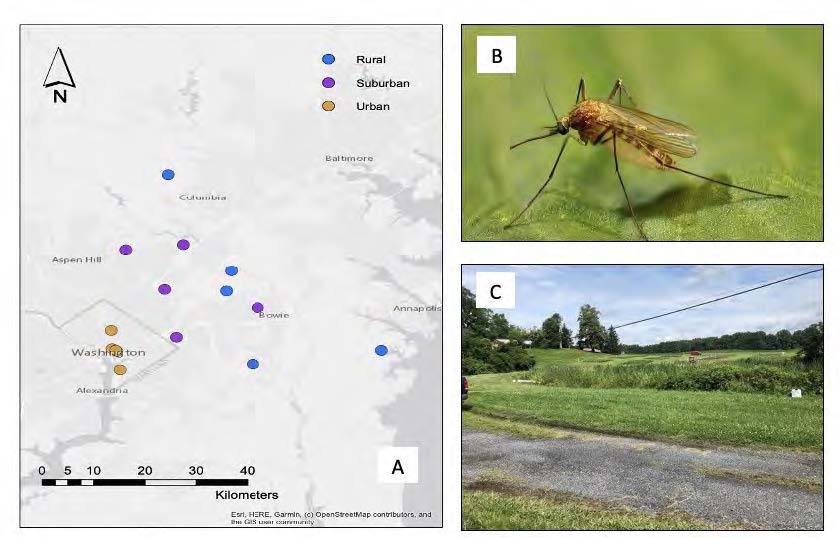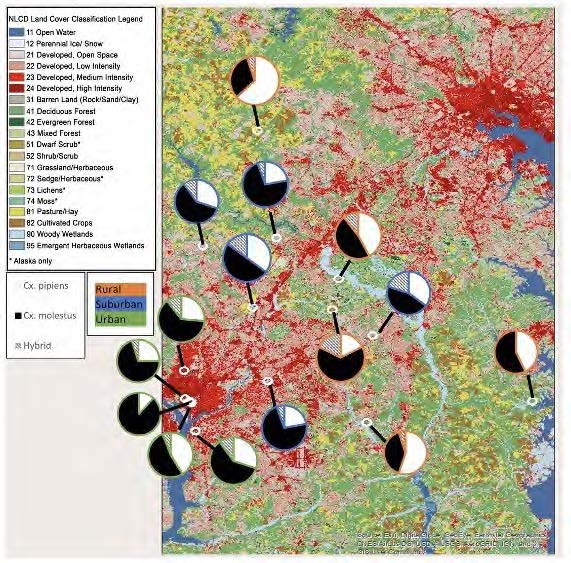Allele Frequencies of Culex Pipiens Bioforms Vary Across an Urban to Rural Gradient in Greater Washington D.C.
Arielle Arsenault-Benoit, PhD Candidate
Sommer Stephens, AGNR SOARE Program
Megan L. Fritz, Assistant Professor
University of Maryland Department of Entomology

Landscape heterogeneity driven by land use, including urbanization, creates diverse habitat and resources for mosquito vectors of disease. Understanding the role of urbanization on mosquito vectors is important because vectors impact the dynamics of pathogen transmission to humans and pose risks to public health. Culex pipiens mosquitoes are important vectors of West Nile virus (WNv) in eastern North America, and are subjects of vector surveillance and abatement efforts across the region. All Cx. pipiens are associated with human land use. Within the species, there are two bioforms, Cx. pipiens f. pipiens and Cx. pipiens f. molestus, that demonstrate different behavioral, physiological, and ecological characteristics.
Differential selection pressures due to landscape heterogeneity may better support one bioform or the other across the landscape. For instance, Cx. pipiens f. molestus use below ground, isolated habitats and tend to take blood meals from mammals, and these behaviors may confer an advantage in urban environments. We predicted that more molestus ancestry would be present in urban environments compared to suburban or rural environments, and the proportion of molestus ancestry would decrease over an urban to rural gradient.
We used molecular techniques to measure pipiens and molestus allele frequencies in populations of Culex pipiens collected from five urban, five suburban, and five rural sites in metropolitan Washington, D.C. during the months of June-October, 2019-2020 (Fig. 1, N=271). Allele frequency distributions along the gradient were transformed to meet normality assumptions and analyzed by ANOVA. We also analyzed patterns of hybridization between Cx, pipiens f. pipiens and Cx. pipiens f. molestus across site classifications using a Hardy Weinberg Equilibrium (HWE) test. HWE describes the principle that genotype frequencies will remain consistent over generations if no evolutionary processes are occuring. We compare observed and expected frequencies of genotypes to calculate whether populations are in or out of equilibrium. If the observed values are significantly different from expected, this suggests one or more of the assumptions of HWE have been violated, including the assumption of random mating.
We found that pipiens alleles were outnumbered by molestus alleles at all but two sites in our study, which were both agricultural sites. The frequency of molestus alleles was significantly higher in urban environments compared to rural environments (Fig. 2). None of the populations across site classes were in Hardy Weinberg equilibrium due to less hybridization than expected.


This suggests that bioforms are not mating randomly, perhaps due to adaptation and reproductive isolation, or habitat partitioning in the environment. Suburban sites had the greatest rates of hybridization between the bioforms, so perhaps the interface between urban and rural environments allows for more genetic mixing between bioforms than other habitat types (Fig. 2,3).
We hypothesized that Cx. pipiens f. molestus characteristics may be advantageous in an urban environment, as they use below ground habitat, prefer mammalian hosts, and can survive in isolation over several generations, and we found that molestus alleles are common in the urban environment and hybrids are rare. Our work demonstrates the influence that human-mediated land use changes have on the distribution of Cx. pipiens bioforms, even on a fine geo-spatial scale. The distribution of Cx. pipiens bioforms and hybrids across a landscape has implications for WNV transmission because host use and host switching leads to epizootic spillover of WNV from avian hosts to humans.